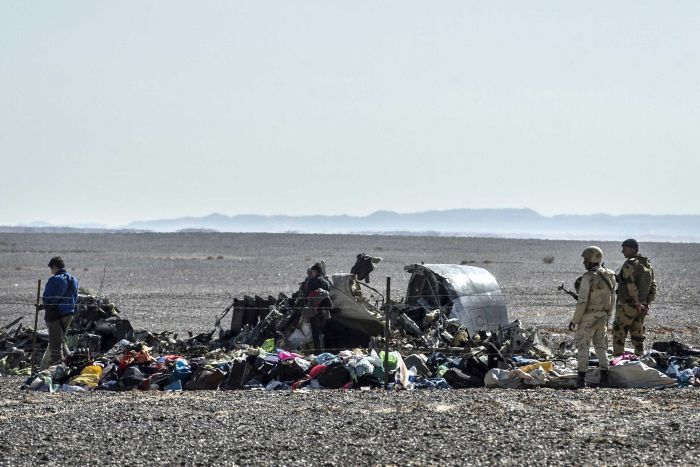Russian plane crash: Experts say small bomb possibly to blame for bringing down airliner over Sinai
Updated
 Photo:
Egyptian soldiers stand guard next to debris and belongings of passengers of the plane. (AFP: Khaled Desouki)
Photo:
Egyptian soldiers stand guard next to debris and belongings of passengers of the plane. (AFP: Khaled Desouki)
Several military experts say a small bomb — either with a timer, or triggered by altitude — now appears to be the most likely cause of the Russian plane crash in Egypt's Sinai desert.
Charles Heyman, editor of annual publication Armed Forces of the United Kingdom, said most analysts had begun to think there was an explosion on board the aircraft.
"Maybe not a huge explosion, but an explosion big enough to actually cause the aircraft to shatter, explode in mid-air and then deposit bits of the aircraft over a large area of ground," Mr Heyman said.
He said even a very small bomb smuggled inside someone's hand luggage would have enormous force at such altitude because the cabin was pressurised.
Russian airline Kogalymavia has said the Metrojet Airbus A321 came down from about 30,000 feet because of "external" factors, with human error or a technical fault now ruled out as the cause.
The carrier's management confirmed no emergency call was made by the pilots during the flight, saying the crew "totally lost control" and did not attempt to make any contact.
At a press conference, Kogalymavia deputy general director Alexander Smirnov said "some kind of external action" was "the only explanation".
 Photo:
Charles Heyman said the size of the debris field supports the bomb theory. (AFP: Khaled Desouki)
Photo:
Charles Heyman said the size of the debris field supports the bomb theory. (AFP: Khaled Desouki)
Missile attack 'unlikely, but not impossible'
Mr Heyman said it was unlikely — although not impossible — that Islamic State (IS) or other militants in the Sinai could have brought the plane down with a missile.
But IS — if it has missiles at all — is likely to have only shoulder-launched or man-portable missiles, which are not capable of striking a plane above 15,000 feet.
"If they're going to hit an aircraft at 30,000 feet, they would need a BUK or a SAM 6," he said.
"Something that is on tracks, and a very large missile with a sophisticated guidance system.
"It's a large piece of equipment that you wouldn't be able to hide very easily."
It was a BUK missile — effectively an upgraded version of the SAM 6 — that investigators concluded brought down the Malaysian Airlines plane MH17 from a cruising altitude over Ukraine in July 2014.
Mr Heyman said any such missile in the Sinai could only realistically be sourced from the Egyptian army, which he said was highly unlikely.
"The percentage chance of that happening is quite small," he said.
"The Egyptians would know immediately that they'd lost it.
"ISIS would have to drive it around, and it would have a signature that you could pick up quite easily.
"And you would have to have people who are trained to use it."
Burn marks point to bomb explosion
Mr Heyman said evidence of burning on the rear of the plane bolstered the theory that a bomb brought the airliner down.
"There are apparently some scorch marks, evidence of burning, towards the tail end of the aircraft," he said.
"I think the evidence is beginning to point towards some sort of small bomb on board... maybe from about a 60 per cent possibility now, as opposed to other options".
A lot of people working on the aircraft itself might be able to get something on board, especially in the area of the Sinai where ISIL is very active.
Charles Heyman
Justin Bronk — a research analyst at the Royal United Services Institute in London — agreed with the growing consensus that an on-board bomb was the most likely cause of the crash.
"It's certainly interesting that it's very early that technical failure or pilot error has been ruled out," Mr Bronk said.
"It's very early to say, but certainly at this point a bomb is probably the most likely scenario that makes sense."
British military analyst Paul Beaver also said he thought the crash was most likely caused by a bomb on board.
He told Britain media he was certain ISIS did not possess a missile system capable of hitting the plane.
"I'm pretty convinced that ISIS doesn't have a 'double-digit' SAM [surface to air missile] that is necessary to go up as far as 31,000 feet," he said.
"That's a very serious piece of equipment, and I don't think they have that sophistication."
Andrew Davies, a senior analyst for defence capability at the Australian Strategic Policy Institute in Canberra, agreed that it was unlikely to be a missile that brought the Russian airliner down.
"If the reports are right that the aircraft came down from 30,000 feet, that's well above the range of shoulder-launched anti-aircraft weapons," Mr Davies said.
But he acknowledged it was not impossible a shoulder-length missile had struck the plane soon after takeoff.
"There was a freighter aircraft flying out of Iraq in the early 2000s that had an engine that was hit by a man-portable missile," he said.
"That aircraft flew for a considerable time — about half an hour — and the pilots managed to get it back under control and through an amazing piece of flying, managed to land it with one engine out and one wing on fire.
"So it's conceivable, but the aircraft would have made reports to the ground had it been flying under that sort of difficulty."
 Photo:
A map of the Sinai Peninsula in Egypt shows the flight path of the Airbus A321. (RNGS Reuters)
Photo:
A map of the Sinai Peninsula in Egypt shows the flight path of the Airbus A321. (RNGS Reuters)
Mr Davies said it was possible IS had its hands on a BUK or SAM 6 missile in Syria, but highly unlikely it could have been smuggled into Egypt.
"There's an outside possibility in somewhere like Syria, because the Syrian government does have quite sophisticated air defences," he said.
"So if ISIS was to capture something there, but there's no evidence of that either. I think it's a pretty long shot."
Mr Davies agreed that a small bomb was more likely to have brought the plane down.
"Depending on where it's placed, it takes a relatively small amount of explosives," he said.
"And the fact that you can't take more than 100ml of liquid onto an aeroplane probably tells you what sort of scale you're talking about."
Wreckage size supports bomb theory
Mr Heyman said the size of the debris field also supported the bomb theory.
"If the aircraft had just come down of its own volition and crashed into the ground, the area of wreckage would be much less than that — well under half a square mile or so. It does look like there's been an explosion," he said.
Mr Heyman said concerns about security at Sharm el-Sheikh airport also suggested it might be more vulnerable than other airports to such an attack.
"It would be very difficult with some airlines. But we're not sure about just how stringent the security precautions are at Sharm el-Sheikh," he said.
"Remember that a lot of people working on the aircraft itself might be able to get something on board, especially in the area of the Sinai where ISIL (IS) is very active."
The defence analyst also discounted the credibility of a video IS posted online over the weekend, purporting to show the doomed airliner's last moments before plunging to the ground.
He said it may instead be older footage of another plane shot down in Syria.
"It does show, we think, an aircraft coming down. But ... the size of the aircraft and the distance from where the video was taken makes it very difficult," he said.
"It's similar to some videos that we've seen that showed aircraft coming down in Syria — Syrian government aircraft shot down by ISIS there.
"But you can't actually look at [the video] and say yes, this is absolutely that aircraft being shot down by ISIS."
Mr Heyman said if IS had brought down the Russian Metrojet plane, there would be serious implications for aviation security across the region and even beyond.
"It's going to make people think very long and very hard about how they actually achieve sensible security, especially on some of the airfields that are at risk," Mr Heyman said.
"Airfields like Sharm el-Sheikh, maybe all the airfields across the Middle East where there are Russian, American, British carriers, French carriers, flying out of."
 Photo:
A child's shoe is seen in front of debris from the plane crash. (Reuters: Mohamed Abd El Ghany)
Photo:
A child's shoe is seen in front of debris from the plane crash. (Reuters: Mohamed Abd El Ghany)
Topics: air-and-space, accidents, disasters-and-accidents, unrest-conflict-and-war, terrorism, egypt, russian-federation
First posted







